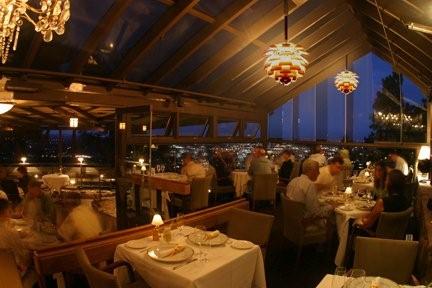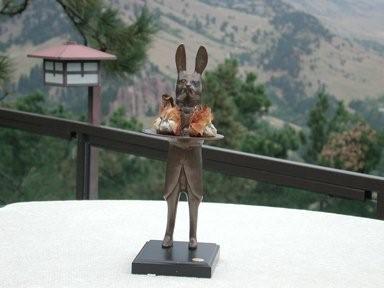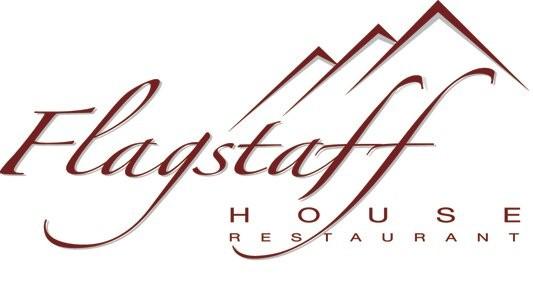
The Flagstaff House Restaurant sits nestled on the mountain
side at an elevation of 6,000 feet and was originally a
cabin built in 1929. Frankly, I though that I had made a
wrong turn. My Garmin kept indicating “Next Right”, but all
I could see while rounding the curves was the sharp
drop-off the side of the mountain. But, just when I was
about to turn around, the Flagstaff appeared.
The Monette family, owners since 1971, and have created a
lush mountain retreat just outside Bolder Colorado with
floor to ceiling glass walls and several outside terraces.
First up on the menu are breathtaking views of Boulder below,
along with abundant wildlife. But, on this trip the mountain
were being bathed in a rare summertime rain storm with low
clouds touching the hill tops.
What brought me to Boulder this time was the The Flagstaff’s
prestigious awards, including Colorado’s only Wine Spectator
Grand Award (which they have held since since 1983). In fact,
they are only one of 86 restaurants in the USA that hold this
award.
The starter for the meal was a presentation of chef’s selection
amous bouche on a handy (if not quirky) bronze rabbit butler.

My fare for the evening was the Chef’s Tasting Menu. This was
a nine course presentation with each course paired with an
appropriate wine.
Course 1 – Wianno Oyster with Lime & Tanqueray Gin (Wine: Fukucho
“Moon over Water” Junmaiginjo Sake, Hiroshima, Japan)
The earthiness of the oyster was the underpinning with an
overlay of lime and juniperberry. Dutifully paired, the sake
provided a sea breeze aroma and a wisper of anise on the palate
Course 2 – Hamachi Yellowtail, Hawaiian Hearts of Palm with
Mizuna, Avocado and Pomegranate (Wine: 2007 Naia, Verdejo,
Rueda, Spain)
The yellowtail was light as air and was appointed with crisp,
tangy greens and sesame. The only weight in this preparation came
from the avocado with its great slippery feel. The wine
was suitably crisp with a hint of lemon zest on the nose
but a deeper tannic sensation on the tongue likely from extended
skin contact.
Course 3 – Alaskan Halibut, Potato Crusted with Arugula, Tear
Drop Tomato, Nicoise Olive, Roasted Peppers, White Tuffle
Balsamic Vinaigrette (Wine: Solar Chardonnay, Sonoma-Monterey-
Santa Barbara, California)
The food had a richness carried by the depth of the olives,
roasted garlic and the oily extravigance of the halibut. The
wine brought citrus and pineapple on the nose and followed
with a light toast, green apple character.
Course 4 – Day Boat Scallop with Fingerling Potatoes, Bentons Ham,
Cipollini Onions, Spinach and Hon Shimeji Mushrooms
(Wine: 2007 Alban Viognier, Central Coast, California)
So much in such a small preparation….most notable being the
extreme silkiness of the creation punctuated with an ending
“hard stop” of the spinach on the palate. This combined with
a similar soft, silky quality of the wine. Wine descriptors also
included: Honeysuckle and ripe musk mellon.
Course 5 – Quail, Pancetta Wrapped & Grilled with White Truffle
Inflused Italian Heirloom Polenta and Garlic Sauce
(Wine: 2004 Marques de Grinon, Caliza, Syrah/Graciano, Spain)
Flavors exude from this preparation – pancetta, truffles, garlic
and fire grilled quail. The wine (a blend of Syrah and the Spanish
native Graciano) was up to the pairing. It carried an aroma of
dark berries and smoke and huge blackberry flavors and a big tannic
bite – What I call the “Teeth of the Grape”, but when put up to
this full bodied preparation it paired well.
Half way through…. Will I make it to the end? Will they have to carry
me out in a body bag? So far, it has been almost too good to keep on
living! I can almost hear the angles over head…..
Course 6 – Duck Breast, Crispy Seared, Duck Confit with Potato Gnocchi,
Grilled Raddichio, Pearl Onion, Rappini, Sherry Gastrique (Wine: 2006
Vinosia “Essenza di Primitivo”, Campania, Italy)
Just when I thought that it could not get any better than the last
course, this one showed up. A great combo of flavors, but the infusion
of black pepper in the sherry sauce with the duck was memorable,
particularly when the wine provided the right response: Blackcherry
nose, more cherries in the taste and a finishing punch of black pepper.
Intermezzo – Raspberry Sorbet
Time to walk around, talk to someone at an adjacent table, and take a
deep breath and get ready for the finish. Now, a most pleasant
surprise…..
At the adjacent table, I noticed that it was a family dinner gone bad:
Husband, wife and three children. Unfortunately the youngest child was
having a bad day and the wife had to take him home. This was after the
husband had the Sommelier open what looked like a
memorable bottle of wine as they talked and tasted for quite a long
time on it. But, he was now left to savor his booty alone. So, I stopped
by and asked him about his wine. He seemed agreeable to talk and share.
Side Story: Unfortunately, his wife drove home and he had left
his wallet in his car. In order to get away at the end of the dinner,
he had to leave his designer wrist watch as collateral.
His wine was a 1997 Peter Michaels (Cab Rich – Bordeaux Blend). After
11 years, this wine had a youthful, fruit-driven character but had also
developed an earthy complexity with dark berries and cassis with
coffee, tobacco, and vanilla.
Ohhhh, life is so good!
Course 7 – Colorado Buffalo Medalions with Fava Beans, Black Truffle
Sauce (Wine: 2004 DuMol, Syrah, Russian River Valley, California)
This course provided a wonderful “Flavor Bomb” in the menu
depending heavily on the earthly aromas of black truffles and garlic.
The wine responded in kind with aromatics of its own: Ripe berries,
burnt toast, wet earth and mushrooms followed by crisp acidity that
performed surgery into the heart of the Chef’s preparation.
Course 8 (Pre-dessert) – A trio of fresh fruit sorbets (Mango, Rasberry
and Lime) to refresh and prepare my palate for the finish.
Course 9 – Vahlrohna Chocolate Tart with Honey Roasted Appicots (Wine:
1977 Porto Barros, Colheita, Portugal)
Valronha Chocolate (71% Pure)….Darker than dark chocolate pulled up
with the fruity highlights of the roasted appicots. The wine paired
well with nice notes of fig and caramel on the palate still having good
crisp acidity.
Well, time to go. My over all impression was that this was one of the
best wine services I had ever had particularly with the number of
courses involved in this meal. In past experiences with nine course
affairs, usually the food comes and the wine is delayed or visa versa.
But, in this case, the food and wine were coordinated perfectly. The
servers were knowledgable and could respond to my incessant questions.
Best if all, what I am left with are “pictures” of a delightful, three hour
wine and food extravaganza caught in the “Camera of my Mind”.
Recommendation: Yes, most definitely, but only if you have the time,
fortitude and a true love of food and wine. It is worth the price
of the meal, the airfare to Boulder, Colorado, and the rental car
thrown in, as well!


While in Colorado try the wines…..we are up and coming
Best Colorado grape
Riesling
Finding a grape that is best suited to a given climate, geography and set of soil conditions may seem simple, but it is really a complex process. To begin with, finding the best grape is not the same as producing wines from that grape that have sales potential. Riesling is a cold-climate grape native to Germany. Many experts claim that it is the finest white grape in the world because of its ability to show off its growing environment without losing any varietal character and the ability to produce long-lived wines. Colorado wine makers have produced very good examples of Riesling in a wide range of styles: dry, off-dry and late harvest, even an ice wine. The grape has proven capable of remaining consistent despite extreme variations in winter conditions in Colorado.
Best Colorado wine, white
2004 Colorado Riesling
Plum Creek Cellars
If Riesling is Colorado’s best wine grape, then Plum Creek’s 2004 Riesling is the best white wine from Colorado wine country. Winemaker Jenne Baldwin won the hearts of the judges at last year’s Colorado Mountain Winefest with this offering, which won an unusual Double Gold rating. Baldwin has created a delicately sweet wine, but not cloyingly so, with floral scents that remind you of fruit trees in bloom. The winery is sold out of the 2004 vintage, but you can still find it in some liquor stores. Owner Doug Phillips says the 2005 vintage, which will be in bottles soon, may be even better. http://www.plumcreekcellars.com (970) 464-7586
Best Colorado wines, red
A basket of “bests.” Colorado reds can be very good; the quality and unique attributes of the fruit grown here ensure it. But assessing Colorado red wine can be problematic because the state’s relatively young wine industry has yet to produce consistently good red wine in quantities that make it easy to find and buy. Among the best currently available:
Bookcliff Vineyards 2003
Cabernet Franc Reserve
The silver medal winner at the Indy International Wine Competition, this wine was barrel-fermented in French oak for 18 months using estate-grown grapes.
http://www.bookcliffvineyards.com; (970) 945-2723
Alfred Eames Cellars 2003 Menage
(40% CS, 30% M, 30% CF)
Bright and elegant expression of the Bordeaux spirit with intense dark berry fruit and polished structure.
http://www.alfredeamescellars.com; (970) 527-3269
Creekside Cellars 2003
Cabernet Franc Reserve
Powerful and dark wine, with luscious plum fruit upheld by massive, velvety tannins. A treasure to put away in the cellar for several years,
http://www.creeksidecellars.net
(303) 674-5460
Best wine resort
Aspen
Easy! With one of the largest concentrations of master sommeliers of any town, including Richard Betts and Jason Smith of the Ritz Carlton and Jay Fletcher of Aspen Wine Sense, four and five-star restaurants and hotels, acclaimed chefs and extensive wine lists, who could argue that Aspen is the best wine resort in the state? Add to that the renowned Food & Wine Classic (yearly mid-June). All this would be difficult to match. Not bad for a town of 6,000 permanent residents.